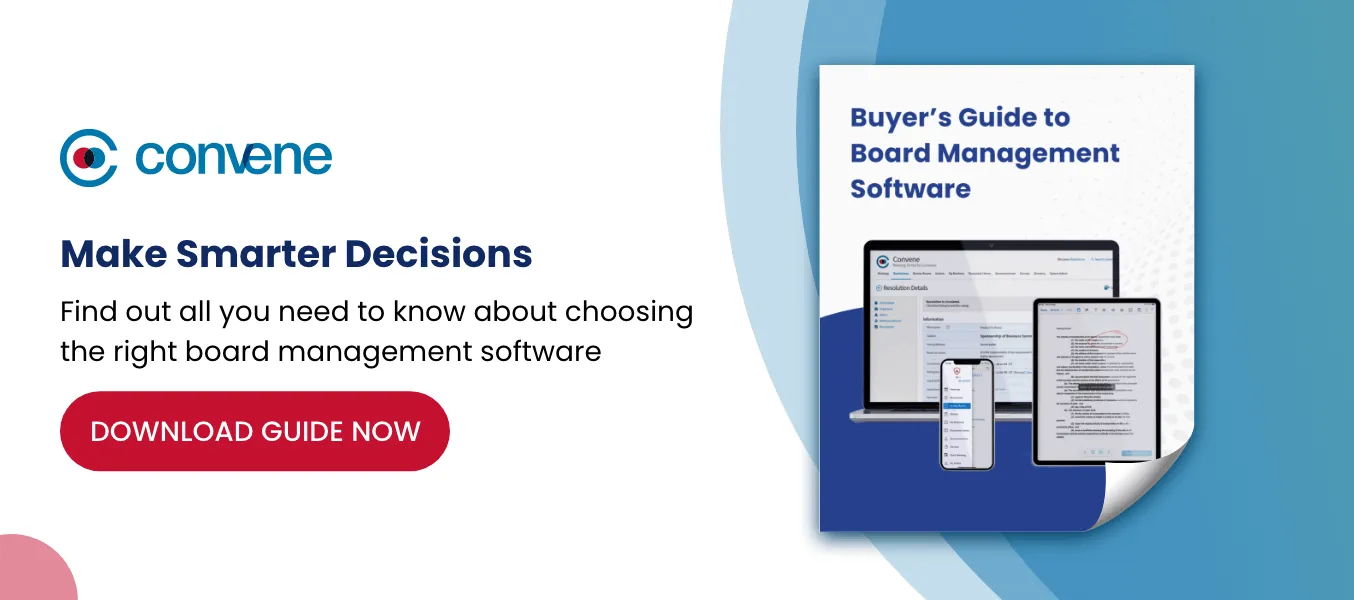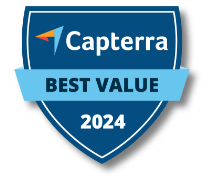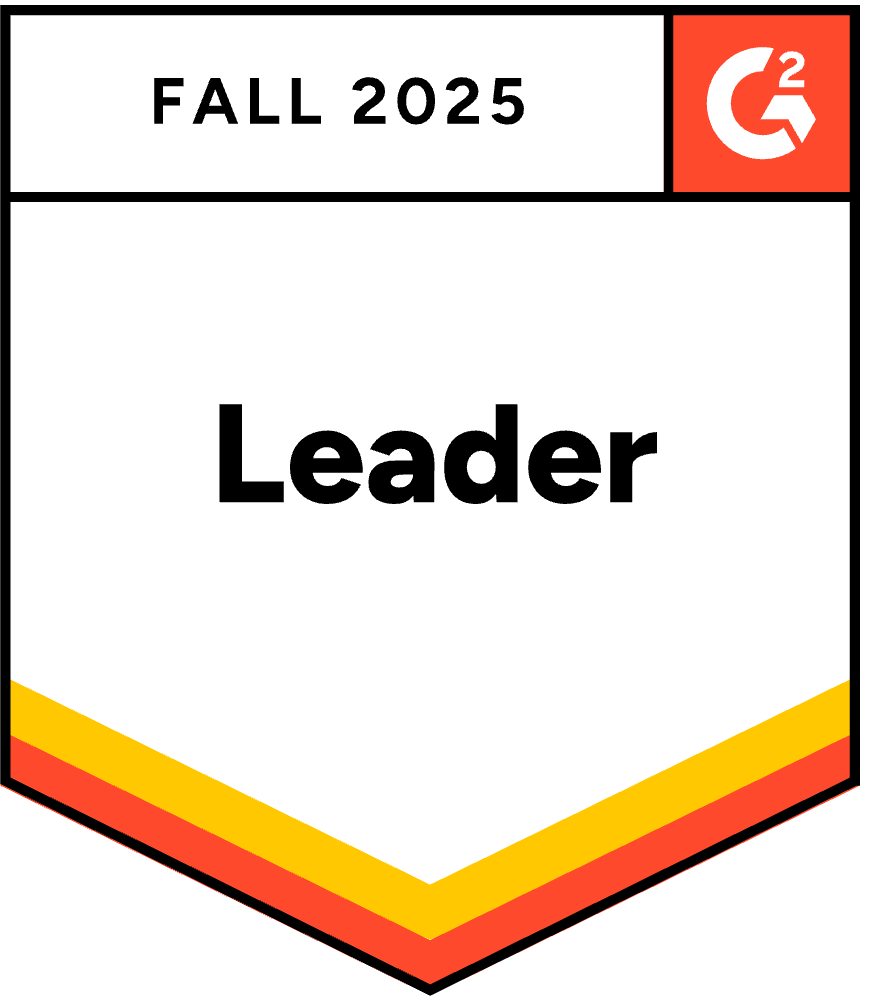How do you plan to grow your business over the next three to five years? Don’t miss out on valuable opportunities—prepare in advance and enhance competitiveness with a strategic plan.
A recent survey by McKinsey & Company reveals that organizations with strategic plans outperform peers in both growth and return on capital. For many, long-term planning has become a priority.
However, there are still those caught in short-term planning, focused on adapting to sudden market shifts quarter by quarter instead of envisioning the bigger picture for the years ahead.
To improve resilience, organizations need not just to prepare for the next quarter but for the long term. This article explores what is a strategic plan, why it matters, strategic plan structure, and best practices for how to write a strategic plan using proven frameworks that drive business growth.
What is a strategic plan?
A strategic plan outlines where the organization is at present and where it wants to be in the future. Typically, it’s a long-term business outlook that spans three to five years—or, for some, even longer. It’s a document that defines the organization’s overarching objectives, major projects, resource allocation plan, and implementation and evaluation timelines.
The board of directors and executives initiate strategic planning from the top, where they assess internal and external factors impacting success, then set priorities and allocate resources toward shared objectives. Laying out a comprehensive plan encourages greater buy-in from shareholders and aligns the entire organization around a unified strategic direction.
For a strategic plan to be effective, it must stay true to the organization’s values, ground initiatives in accurate data, and set practical steps for execution. Additionally, it’s equally important to assess and tackle strategic risks, which typically arise from market shifts, technological disruptions, regulatory changes, or internal skills gaps. According to Professor Felix Oberholzer-Gee of Harvard Business School, organizations should evaluate these risks across four key perspectives: financial, customer, internal, and learning and growth.
Related Reading: What is Strategic Risk? Definition, Examples & Management Tips
How does a strategic plan help with business success?
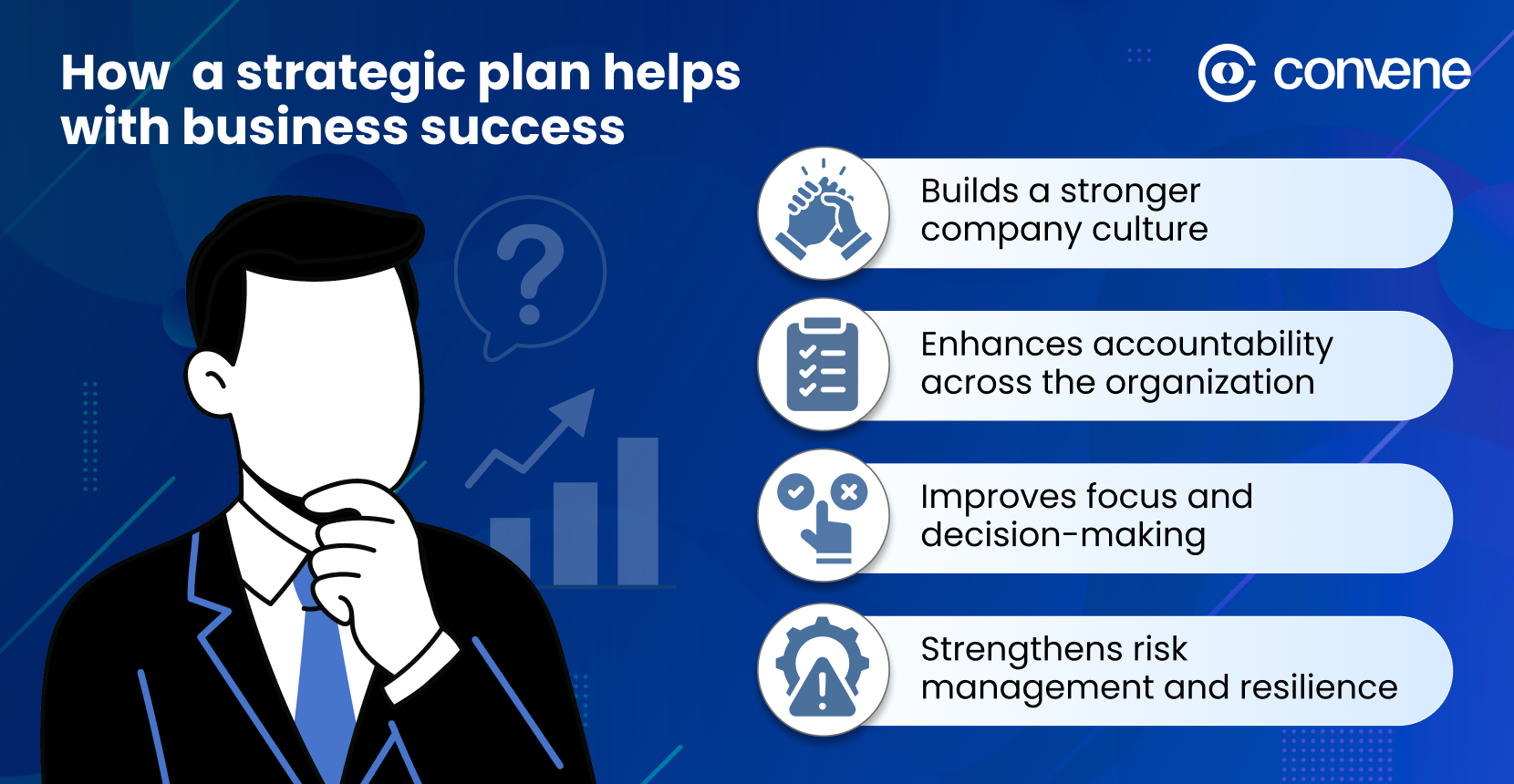
The benefits of a strategic plan encompass operations, governance, and company culture. Here’s exactly how strategic plans are enhancing business competitiveness, along with case studies of renowned companies to better illustrate.
Builds a stronger company culture
Strategic plans incorporate organizational mission, vision, and values. It makes it easier for teams to align their decisions and actions with both core principles and overall business objectives.
Take Patagonia, for example. Since its founding in the United States, the retail company has fostered a purpose-driven culture, where employees aren’t confused about aligning their actions with both goals and values. Over the years, its advocacy for environmental responsibility has remained evident in its business strategies, which employees are actively upholding as they perform tasks.
Enhances accountability across the organization
The board of directors utilizes strategic plans to delegate responsibility and set targets. Business growth is achieved through collective effort, and a strategic plan puts everyone on the same page, therefore, encouraging more participation.
Many global companies exemplify efficient use of strategic plans for this. In 2022, Starbucks announced “Triple Shot Reinvention, with Two Pumps”—a strategic plan to elevate the brand, scale digital initiatives, and expand to more locations. These declarations created a new set of responsibilities, particularly to regional directors and store managers. Additionally, the plan streamlined KPIs on sales targets, new store openings, and customer satisfaction.
Improves focus and decision-making
Building a strategic plan provides clarity on goals and priorities. It enables organizations to make more focused, informed decisions, streamlining not only discussions but also resource allocation, operations, and governance.
Apple Inc. is a prime example of this. It has long been established that innovation and seamless ecosystem integration are its top priorities. While demand for non-mobile gadgets accelerates, Apple remains steadfast in developing products that only fit within its ecosystem. For years, this has helped them solidify their brand identity, which has also improved customer loyalty and sustained growth.
Strengthens risk management and resilience
Strategic planning urges decision-makers to anticipate risks and take proactive steps to minimize their impact. It equips teams with a structure to effectively navigate shifting markets, resulting in better financial control and smoother project implementation.
In their 2030 roadmap, Shell balances domination in the traditional energy market with expansion into alternative energy. The plan excels at addressing both market and operational risks and harnessing them to develop a holistic strategy for strengthening resilience and adaptability to changing market demands.
What are the five essential parts of a strategic plan?
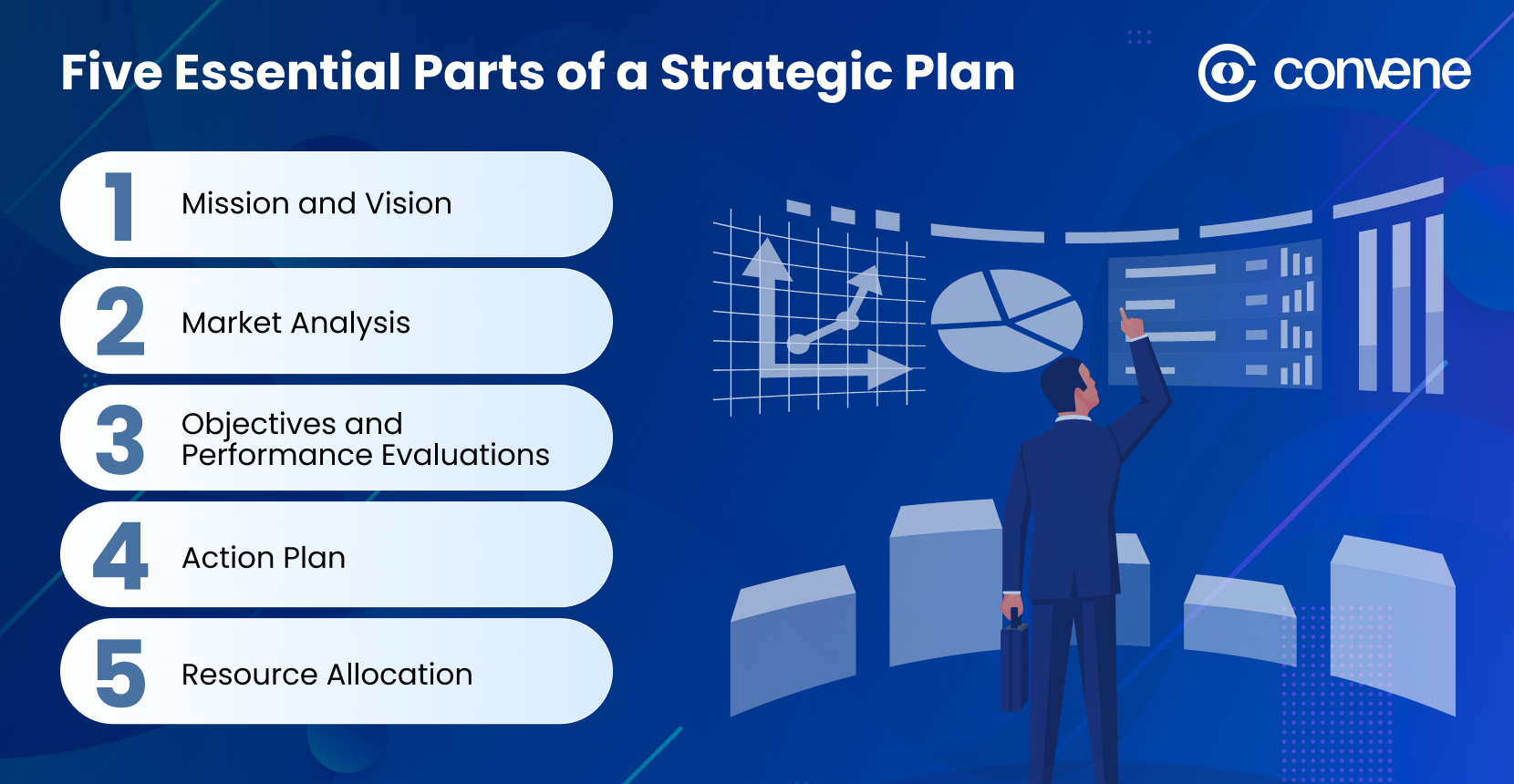
Now that you know how important a strategic plan is, you should also know what makes a well-made one. Here are the key components of a strategic plan.
1. Mission and Vision
It starts by defining the purpose and long-term aspirations with mission and vision statements. The mission clarifies why the organization exists, and the vision outlines the future state it aims to achieve. These guide management as they draft the strategic planning documents, promoting cohesive planning and principle-driven decision-making.
2. Market Analysis
Assess your current market position before planning the years ahead. Perform situational analysis using strategic planning frameworks to identify internal and external factors that impact the business’s success.
For example, this section helps uncover internal challenges, such as operational gaps, leadership challenges, and resource constraints. Externally, it reveals strategic risks, market trends, regulatory changes, and competitive pressures—all of which empower management to develop an informed, data-driven strategic plan.
3. Objectives and Performance Evaluations
Form smart goals alongside clear benchmarks to measure progress effectively. Beyond financial success, it’s also crucial to take a comprehensive approach and consider customer success, internal business processes, financial performance, market share, and employee growth.
To support holistic evaluation, establish benchmarks to track performance at every level.
- Baseline benchmarks indicate the organization’s current state and serve as reference points for measuring improvement.
- Target benchmarks define the criteria for success to be achieved within the set timeframe.
- External benchmarks provide a framework for comparing performance against industry peers or competitors, enabling teams to uncover gaps and competitive advantages.
Since a strategic plan has a longer timeline, certain market factors are bound to impact internal priorities. Enhance adaptability by conducting regular reviews of the strategic plan to ensure it stays aligned with evolving market conditions.
4. Action Plan
Translate high-level strategies into execution by forming an action plan that specifies deliverables, project owners, and timelines. Breaking down the overall objective allows management to distribute accountability and determine dependencies between departments accordingly.
5. Resource Allocation
A strategic plan outlines resource allocation to inform teams of the available funds, people, and assets before proceeding. This enables the management to anticipate potential constraints and prioritize initiatives. Be transparent about funding sources and cost-control measures to achieve financial stability throughout the execution.
How to Write a Strategic Plan: Best Practices in 2026
Organizations need resilient strategies now more than ever to keep pace with market shifts. To start 2026 on the right footing, here are some best practices in strategic planning to help you stay ahead.
1. Set clear objectives
Avoid vague or unrealistic targets by prioritizing clarity and relevance when setting objectives. Translate high-level objectives into actionable steps, then define each goal and explain why it matters. This would help teams understand the overall direction, making it easier for them to show support and align their actions.
2. Embrace data analytics
The ability to manipulate data has become a competitive advantage. Organizations shouldn’t overlook data analytics and its role in building a strong foundation for accurate data collection and analysis. Statistical analysis, predictive modeling, and machine learning are examples of modern data tools and techniques that speed up insight generation. These models reduce uncertainty and empower decision-makers to anticipate trends and mitigate risks with greater precision.
3. Adopt AI-driven technologies
Look into AI-driven technologies to make strategic planning more practical and accurate. At the management level, AI-driven board portals are reinventing collaboration and decision-making with smart assistants and automated meeting summaries and workflows. These intelligent systems are streamlining administrative burdens, allowing decision-makers to focus more on strategic planning.
Related Reading: AI for Board of Directors: Revolutionizing Corporate Strategy and Decision-Making
4. Value stakeholder engagement
Establish clear communication with stakeholders, from strategic planning to execution, to consider their diverse perspectives throughout the process. Inclusive strategic planning ensures every aspect is reviewed, preventing blind spots that may have been overlooked by management. Consider conducting annual general meetings or workshops to engage with stakeholders.
5. Strategy reevaluation and refinement
Schedule regular checks on your strategic performance and overall plan to ensure alignment across teams and objectives. This should involve comparing your strategic roadmap against current progress to identify gaps and bottlenecks for optimization.
For larger organizations, establishing monitoring and reporting systems can enhance visibility on all KPIs, making it easier for management to make data-driven adjustments in real-time. Additionally, encouraging feedback from departments can capture ground-level insights for more practical refinements.
Eight Strategic Planning Frameworks for Effective Business Growth

Strategic planning frameworks are methods organizations can use to set goals and develop execution plans. Learn about these various approaches through the list below.
1. SWOT Analysis
The SWOT analysis examines the internal (strengths and weaknesses) and external (opportunities and threats) factors that impact business success. Ideally, this is used at the beginning of strategic planning to understand the organization’s present market position and gaps.
2. PEST Analysis
This is for businesses that want to assess the macro-external factors surrounding the business, i.e., political, economic, social, and technological factors. It provides a broad view of how these affect current operations, helping organizations anticipate and prepare for potential disruptions.
3. Issue-Based Strategic Planning
Unlike goal-oriented approaches, this directly identifies critical business challenges. By addressing these issues first, organizations can create a more focused long-term plan.
4. Objectives and Key Results (OKRs)
This is a goal-setting framework that outlines company-wide objectives and key results. It uses a bottom-up approach, enabling teams to set their own OKRs, as long as they align with the company’s overarching goals.
5. Balanced Scorecard
Balanced scorecard is a performance management tool that connects strategic goals with performance metrics across key areas: objectives, measures, initiatives, and action items.
6. Porter’s Five Forces
Developed by Michael Porter, this tool analyzes an industry’s competitiveness through five forces:
- Bargaining power of buyers
- Bargaining power of suppliers
- Threat of new entrants
- Threat of substitute products or services
- Rivalry among existing competitors.
- Reviewing these forces helps in identifying risk management opportunities.
7. Strategy Mapping
Strategy mapping uses visual charts to illustrate the cause-and-effect relationships between strategic objectives. It’s ideal for organizations that want a clear visual representation of their strategic plans
8. Strategic Gap Analysis
Gap analysis compares the present business state to desired outcomes for organizations to uncover gaps that hinder progress. Insights from this framework help in developing specific steps in order to achieve a particular goal.
Key Differences Between a Strategic Plan, Business Plan, and Annual Operating Plan
The similarities among strategic, business, and annual operating plans often cause confusion among teams. All three are useful for planning and execution, but they differ mainly in purpose, timeframe, and audience.
To better understand what sets them apart, here’s a brief side-by-side comparison.
| Aspect | Strategic Plan | Business Plan | Annual Operating Plan (AOP) |
|---|---|---|---|
| Purpose | Commonly used by established organizations for projecting long-term plans. | Ideal for short- to medium-term projection; mostly used by startups or scaling organizations. | Lays out business and financial objectives for the fiscal year. |
| Timeframe | Three to five years | One to three years | Twelve months |
| Target Audience | Internal stakeholders (executives, department heads, managers, employees). Used to align the organization around shared goals and vision. | External stakeholders (investors, lenders, partners, regulatory bodies). Used to secure funding, investments, or partnerships. | Internal stakeholders refer to it as a guide for executing annual business objectives. |
Purpose
The most comprehensive among the three is the strategic plan. It’s commonly used by established organizations to project long-term plans, serving as a blueprint to navigate evolving markets. A business plan, on the other hand, is ideal for short- to medium-term projection. Startups or scaling organizations use it to attract investors, secure loans, or gain stakeholder buy-in.
Unlike the two plans that last longer than a year, an AOP lays out a one-year execution roadmap. It outlines immediate business and financial objectives that organizations must achieve within the fiscal year.
Timeframe
A strategic plan spans three to five years to provide enough time for management to change market position and boost overall performance. A business plan follows a shorter timeframe of one to three years, defining operational and marketing strategies to improve profitability and financial stability. Lastly, an AOP covers only twelve months.
Target Audience
Both strategic and annual operating plans are targeted toward internal stakeholders (e.g., executives, department heads, managers, and employees). They align individuals around shared goals, guiding them as they execute plans. In contrast, a business plan is intended for external stakeholders (e.g., investors, lenders, partners, and regulatory bodies) and is used more frequently to secure funding or partnerships.
Frequently Asked Questions on Strategic Plans
Who develops strategic plans?
Strategic planning is a collaborative effort that brings together the board of directors, senior leaders, and C-suite executives. Their combined expertise, industry insight, and extensive experiences are pivotal in sharpening the organization’s long-term direction.
Additionally, department heads, employees, and consultants also contribute their ground-level insights to make strategies more realistic and relevant.
When should management review or update strategic plans?
According to Harvard Business School, an annual review is recommended, while updates to strategic plans should be made every five years. Regular evaluation and updates ensure that plans adapt to the evolving market conditions.
What technological tools can streamline strategic planning?
There’s a range of technological tools that can enhance strategic planning, depending on the goal of the organization.
Predictive analytics empowers decision-makers to make data-driven strategies rather than relying solely on intuition. Moreover, AI-driven software, such as board portals, is also becoming in demand as global management teams seek smarter, more efficient ways to collaborate across continents.
Simplify Board Governance and Strategic Alignment Through Convene
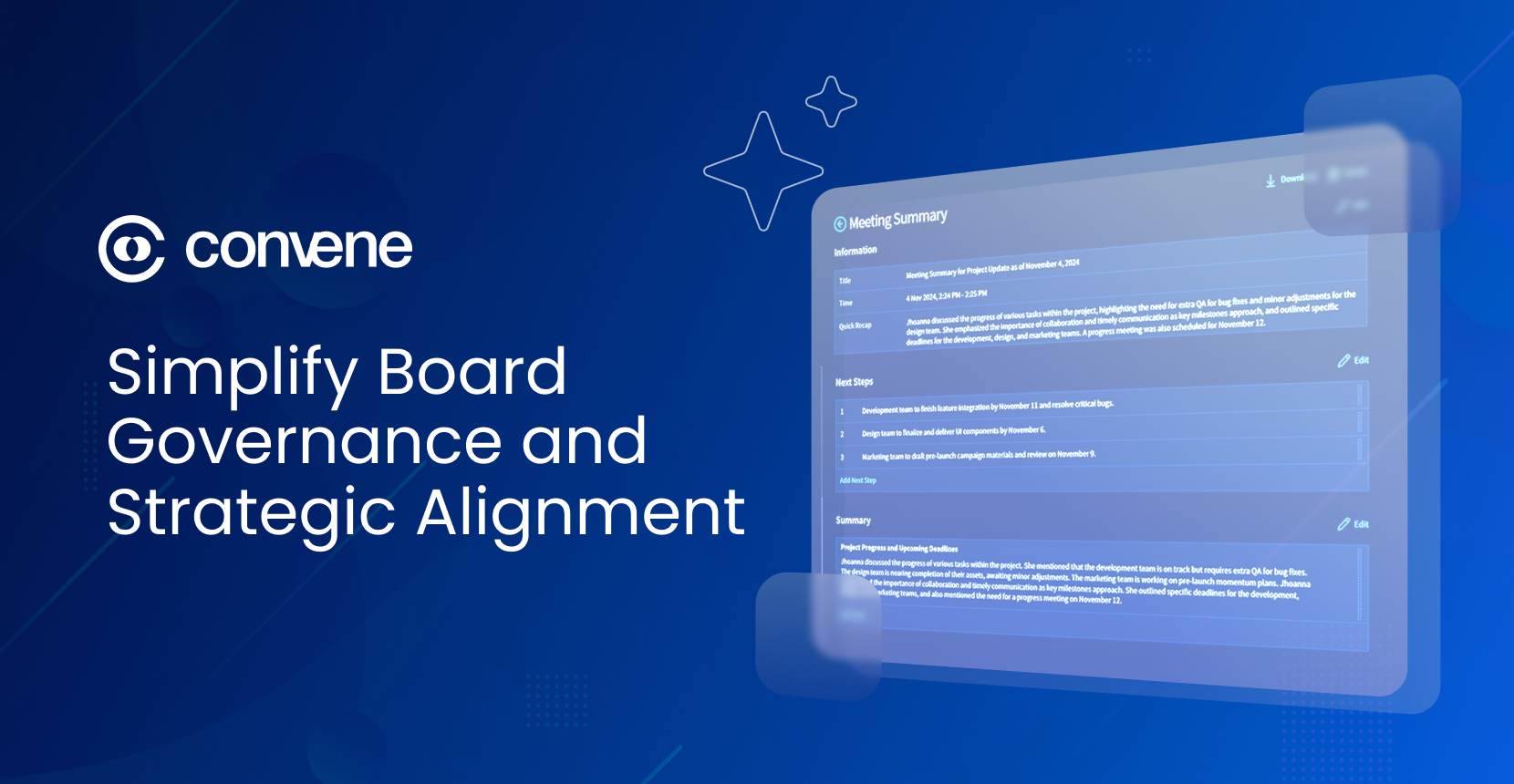
The board of directors and senior leaders are often buried in administrative tasks, which slows down strategic planning. Relying on manual processes for document sharing, meeting management, approvals, and performance tracking increases the risk of inefficiencies and delays.
This is where board portals come in—to digitize and streamline collaboration and governance. Convene board portal makes all the difference for decision-makers.
This AI-driven platform centralizes document storage, automates meeting workflows, and enables real-time collaboration. Its secure environment is built with advanced features for easier alignment, such as automated meeting summaries, third-party integrations with productivity tools, digital signature workflows, and voting capabilities.
By transforming how boards and executives collaborate, Convene empowers leaders to spend less time on administrative tasks and more on governance and strategic planning. Whether it’s time for the annual review of a strategic plan or an update, Convene provides the digital infrastructure your organization needs to keep progress on course.
Ready to simplify strategic planning and board governance? Book a Convene demo today!
Jean is a Content Marketing Specialist at Convene, with over four years of experience driving brand authority and influence growth through effective B2B content strategies. Eager to deliver impactful results, Jean is a data-driven marketer who combines creativity with analytics. In her downtime, Jean relaxes by watching documentaries and mystery thrillers.


